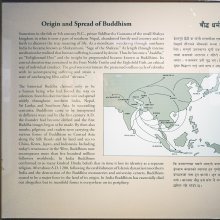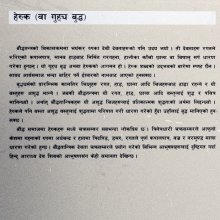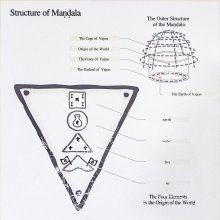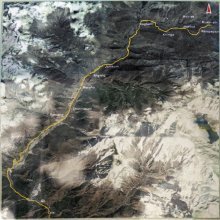Huna, Hūṇa, Hūṇā: 28 definitions
Introduction:
Huna means something in Hinduism, Sanskrit, Jainism, Prakrit, the history of ancient India, Marathi. If you want to know the exact meaning, history, etymology or English translation of this term then check out the descriptions on this page. Add your comment or reference to a book if you want to contribute to this summary article.
Images (photo gallery)
In Hinduism
Purana and Itihasa (epic history)
Source: archive.org: Puranic EncyclopediaHūṇa (हूण).—A tribe. There are a number of references in the Purāṇas to the Hūṇas, who were created from the froth in the mouth of Nandinī, the cow which was in Vasiṣṭha’s āśrama. (Ādi Parva, Chapter 174, Verse 18).
Nakula conquered the Hūṇas in the western regions. (Sabhā Parva, Chapter 32). The Hūṇa kings took part in the Rājasūya of Yudhiṣṭhira and made costly presents. (Sabhā Parva, Chapter 51, Verse 24).
Source: Cologne Digital Sanskrit Dictionaries: The Purana IndexHūṇa (हूण).—A tribe defeated by Bharata; purified of their sin by the worship of Hari;1 specially created in the war of Lalitā with Bhaṇḍa;2 nineteen in number;3 the country of the.4
- 1) Bhāgavata-purāṇa IX. 20. 30; II. 4. 18.
- 2) Brahmāṇḍa-purāṇa IV. 29. 131.
- 3) Matsya-purāṇa 273. 19.
- 4) Vāyu-purāṇa 45. 136; Viṣṇu-purāṇa II. 3. 17.
Hūṇa (हूण) is a name mentioned in the Mahābhārata (cf. II.47.19, VI.10.64) and represents one of the many proper names used for people and places. Note: The Mahābhārata (mentioning Hūṇa) is a Sanskrit epic poem consisting of 100,000 ślokas (metrical verses) and is over 2000 years old.

The Purana (पुराण, purāṇas) refers to Sanskrit literature preserving ancient India’s vast cultural history, including historical legends, religious ceremonies, various arts and sciences. The eighteen mahapuranas total over 400,000 shlokas (metrical couplets) and date to at least several centuries BCE.
Kavya (poetry)
Source: Wisdom Library: KathāsaritsāgaraHūṇa (हूण) is the name of a kingdom that was conquered by Udayana (king of Vatsa) during his campaign to obtain sovereignty over the whole earth, according to the Kathāsaritsāgara, chapter 19. Accordingly, “His glory, after he had inflicted a defeat on the Hūṇas, made the four quarters resound, and poured down the Himālaya like a second Ganges”.
The Kathāsaritsāgara (‘ocean of streams of story’), mentioning Hūṇa, is a famous Sanskrit epic story revolving around prince Naravāhanadatta and his quest to become the emperor of the vidyādharas (celestial beings). The work is said to have been an adaptation of Guṇāḍhya’s Bṛhatkathā consisting of 100,000 verses, which in turn is part of a larger work containing 700,000 verses.
Source: Wisdom Library: KavyaHūṇa refers to an ancient district or cultural territory, as mentioned in the 7th-century Mudrārākṣasa written by Viśākhadeva. Hūṇa corresponds to a western or northern region.
Source: Shodhganga: The Kavyamimamsa of RajasekharaHūṇa (हूण) is the name a locality mentioned in Rājaśekhara’s 10th-century Kāvyamīmāṃsā.—The region of north India. The poet Kālidāsa while describing the Digvijaya of Raghu, mentions this country of the Hūṇas in the northern direction. This part may be identified with the country between the modern Waksh and Aksu, the two tributaries of the Oxus.

Kavya (काव्य, kavya) refers to Sanskrit poetry, a popular ancient Indian tradition of literature. There have been many Sanskrit poets over the ages, hailing from ancient India and beyond. This topic includes mahakavya, or ‘epic poetry’ and natya, or ‘dramatic poetry’.
Jyotisha (astronomy and astrology)
Source: Wisdom Library: Brihat Samhita by VarahamihiraHūṇa (हूण) (Cf. Sitahūṇa, “white-men”) refers to a country belonging to “Uttaratas or Uttaradeśa (northern division)” classified under the constellations of Śatabhiṣaj, Pūrvabhādrapada and Uttarabhādrapada, according to the system of Kūrmavibhāga, according to the Bṛhatsaṃhitā (chapter 14), an encyclopedic Sanskrit work written by Varāhamihira mainly focusing on the science of ancient Indian astronomy astronomy (Jyotiṣa).—Accordingly, “The countries of the Earth beginning from the centre of Bhāratavarṣa and going round the east, south-east, south, etc., are divided into 9 divisions corresponding to the 27 lunar asterisms at the rate of 3 for each division and beginning from Kṛttikā. The constellations of Śatabhiṣaj, Pūrvabhādrapada and Uttarabhādrapada represent the northern division consisting of [i.e., Hūṇa] [...]”.

Jyotisha (ज्योतिष, jyotiṣa or jyotish) refers to ‘astronomy’ or “Vedic astrology” and represents the fifth of the six Vedangas (additional sciences to be studied along with the Vedas). Jyotisha concerns itself with the study and prediction of the movements of celestial bodies, in order to calculate the auspicious time for rituals and ceremonies.
General definition (in Hinduism)
Source: archive.org: Indian Historical Quarterly Vol. 7Hūṇa (हूण) is the name of a country (possibly identified with a Chinese tribe who invaded Himalayan region), classified as both Hādi and Kādi (two types of Tantrik division), according to the 13th century Sammoha-tantra (fol. 7).—There are ample evidences to prove that the zone of heterodox Tantras went far beyond the natural limits of India. [...] The zones in the Sammoha-tantra [viz., Hūṇa] are here fixed according to two different Tantrik modes, known as Kādi and Hādi.
In Jainism
General definition (in Jainism)
Source: archive.org: Trisastisalakapurusacaritra1) Hūna (हून) refers to a sub-division of the Mlecchas: one of the two-fold division of men born in Mānuṣottara and in the Antaradvīpas, situated in the “middle world” (madhyaloka), according to chapter 2.3 [ajitanātha-caritra] of Hemacandra’s 11th century Triṣaṣṭiśalākāpuruṣacaritra: an ancient Sanskrit epic poem narrating the history and legends of sixty-three illustrious persons in Jainism.
Accordingly:—“In these 35 zones on this side of Mānuṣottara and in the Antaradvīpas, men arise by birth; on the mountains, Meru, etc., by kidnapping and power of learning, in the 2½ continents and in 2 oceans. [...]. From the division into Āryas and Mlecchas they are two-fold. [...] The Mlecchas—[e.g., the Hūnas, ...] and other non-Āryas also are people who do not know even the word ‘dharma’”.
2) Hūna (हून) is the name of an ancient kingdom, according to chapter 4.2 [vāsupūjya-caritra].—Accordingly, as Vasupūjya and Jayā spoke to Vāsupūjya:—“All the existing kings, among men and the Vidyādharas, who are of good family, capable, heroic, wealthy, famous, possessing the fourfold army, known for guarding their subjects, free from blemish, faithful to engagements, always devoted to dharma, in Madhyadeśa, Vatsadeśa, [...] and also [... the Hūṇas, ...] and other realms in the north. [...] These now, son, beg us constantly through messengers, who are sent bearing valuable gifts, to give their daughters to you. [...]”.

Jainism is an Indian religion of Dharma whose doctrine revolves around harmlessness (ahimsa) towards every living being. The two major branches (Digambara and Svetambara) of Jainism stimulate self-control (or, shramana, ‘self-reliance’) and spiritual development through a path of peace for the soul to progess to the ultimate goal.
India history and geography
Source: Wisdom Library: India HistoryHuna refers to one of the thirty-six Rajput clans, according to Padmanabha’s 15th-century Kanhadadeprabandha, in which he described the Muslim invasion of Gujarat of 1298 AD. The kingdom or dynasty of the Hunas had their own princes and nobles and were further separated into sub-clans and families. Their name can also be spelled as Hūṇa or Hūna.
The Rajputs are a Hindu race claiming to be descendants of the ancient Kṣatriya-varṇa (warrior caste). Originally, the Rajputs consisted of two principal branches: the Sūryavaṃśa (solar race) and the Candravaṃśa (lunar race), to which later was added the Agnivaṃśa (fire-born race).
Source: archive.org: Personal and geographical names in the Gupta inscriptionsHūṇa (हूण) is the name of a tribe mentioned in the Gupta inscriptions. The Gupta empire (r. 3rd-century CE), founded by Śrī Gupta, covered much of ancient India and embraced the Dharmic religions such as Hinduism, Buddhism and Jainism. These tribes (e.g., the Hūṇas, latin: Hunas) migrated to places other than their original settlemenets and gave their names to the janapadas they settled. They replaced the old Vedic tribes in Punjab and Rajasthan though some of them are deemed as offshoots of the main tribe..
Source: academia.edu: The Chronology of Ancient Gandhara and BactriaHuna Shahi Kings and Patola Shahi Kings (275 BCE to 340 CE).—Hunas were the original inhabitants of North-western India since pre-Mahabharata era. It appears that the Hunas were the vassals of the Kushano-Sasanian kings and had only the title of “Shahi” (King) and not “Shahanushahi”(King of Kings). Most probably, the Hunas had taken over the kingdom of north-western India after the fall of Kushano-Sasanian empire. They also invaded north India for the first time during the reign of Kumaragupta (241-199 BCE). Huna King Toramana Shahi reigned around 190-160 BCE and his son Mihirakula reigned around 160-130 BCE.
Source: academia.edu: Who were the HunasHunas and Harahunas were Indian tribes of North-western region.—Hunas are mentioned as “Mlecchass” in Mahabharata and Purana. Mahabharata also refers to another trine called “Harahuna”. Sabha parva records that Nakula subdued Hunas, Harahunas, Chinas, Sakas, Ramathas etc. in the west. Hunas were dominating in the west during the lifetime of Kalidasa. It is possible that Kalidasa mistakenly speculated them to be Hunas whom King Raghu subdued. In all probability, Hunas were a clan of Kambojas because the Huna King Toramana calls himself “Shahi” in his coins.
Source: What is India: Epigraphia Indica volume XXIX (1951-1952)Hūṇa (हूण) is the name of an ancient tribe, as mentioned in the Maser inscription of a Śulkī chief.—Accordingly, the hero (Kesarin ?) is then stated to have met the Hūṇas, sent by Lolikya, in battle at Paṭṭaṇaka and to have destroyed a large army consisting of horses, elephants, and infantry. Then follows a description of the plight of enemy women who resolved to put themselves to death. In the battles fought by the hero (Kesarin ?) even the skulls of the fallen enemies were not traceable.
Source: Singhi Jain Series: Ratnaprabha-suri’s Kuvalayamala-katha (history)Hūṇā (हूणा) refers to one of the Eighteen types of Horses commonly known to ancient Indian society, according to Uddyotanasūri in his 8th-century Kuvalayamālā (a Prakrit Campū, similar to Kāvya poetry).—The Kuvalayamala (779 A.D.) is full of cultural material which gains in value because of the firm date of its composition. [...] At page 23.22 of the Kuvalayamālā there is an enumeration of 18 kinds of horses, [e.g., Hūṇā], [...].—Also see the Samarāīccackahā of Haribhadrasūri from the beginning of the 8th century A.D.

The history of India traces the identification of countries, villages, towns and other regions of India, as well as mythology, zoology, royal dynasties, rulers, tribes, local festivities and traditions and regional languages. Ancient India enjoyed religious freedom and encourages the path of Dharma, a concept common to Buddhism, Hinduism, and Jainism.
Languages of India and abroad
Marathi-English dictionary
Source: DDSA: The Molesworth Marathi and English Dictionaryhūna (हून).—ind From. 2 Than. 3 This particle, assumed by certain prepositions and adverbs attached to or in construction with words in the plural, is, even by the chastest speakers, constantly made to express the sense, not of ablation or procession--the appropriate senses of From,--but of location; as ikaḍūna, tikaḍūna, cahuṅkaḍūna, durūna or lāmbūna, javaḷūna, āntūna, bāhērūna, madhūna, varūna, khālūna &c., meaning simply Here (not hence), there, on all sides, far, near, within, without &c. This use of hūna is intimated also under varūna, where see some examples.
Source: DDSA: The Aryabhusan school dictionary, Marathi-Englishhūna (हून).—ind From; than.
Marathi is an Indo-European language having over 70 million native speakers people in (predominantly) Maharashtra India. Marathi, like many other Indo-Aryan languages, evolved from early forms of Prakrit, which itself is a subset of Sanskrit, one of the most ancient languages of the world.
Sanskrit dictionary
Source: DDSA: The practical Sanskrit-English dictionaryHūṇa (हूण) or Hūna (हून).—
1) A barbarian, foreigner; सद्यो मण्डितमत्तहूणचिबुकप्रस्पर्धि नारङ्गकम् (sadyo maṇḍitamattahūṇacibukapraspardhi nāraṅgakam); ग्रासं ग्रासं चरतिः कश्चिदेणाङ्कडूणः (grāsaṃ grāsaṃ caratiḥ kaścideṇāṅkaḍūṇaḥ) Rām. ch.6.96.
2) A kind of golden coin, (probably current in the country of the Hūṇas).
-ṇāḥ m. pl. Name of a country or its people; हूणावरोधानाम् (hūṇāvarodhānām) R.4.68.
Derivable forms: hūṇaḥ (हूणः), hūnaḥ (हूनः).
Source: Cologne Digital Sanskrit Dictionaries: Edgerton Buddhist Hybrid Sanskrit DictionaryHūṇa (हूण).—(-lipi), Hun-script, in list of modes of writing: hūna-lipi Lalitavistara 126.1; -hūṇāpīrā (dvandva; sc. lipi) Mahāvastu i.135.6.
Hūṇa can also be spelled as Hūna (हून).
Source: Cologne Digital Sanskrit Dictionaries: Shabda-Sagara Sanskrit-English DictionaryHūṇa (हूण).—m.
(-ṇaḥ) 1. A barbarian, a Hun. 2. A kind of gold coin current in the country of the Hunas; also read. hūna. E. hveñ to call, naka Unadi aff.
Source: Cologne Digital Sanskrit Dictionaries: Cappeller Sanskrit-English DictionaryHūṇa (हूण).—[masculine] [plural] [Name] of a people.
--- OR ---
Hūna (हून).—[masculine] = hūṇa.
Source: Cologne Digital Sanskrit Dictionaries: Monier-Williams Sanskrit-English Dictionary1) Huṇa (हुण):—m. Name of Viṣṇu, [cf. Lexicographers, esp. such as amarasiṃha, halāyudha, hemacandra, etc.]
2) Hūṇa (हूण):—m. [plural] Name of a barbarous people, the Huns (sg. = a king of the Huns), [Inscriptions; Buddhist literature; Mahābhārata] etc.
3) Name of a family, [Catalogue(s)]
4) of a people living in Bhārata-varṣa, [Monier-Williams’ Sanskrit-English Dictionary]
5) Hūna (हून):—m. (often incorrectly for hūṇa) a kind of gold coin current in the kingdom of Mādra (commonly called a Pagoda and worth about 8 shillings), [Monier-Williams’ Sanskrit-English Dictionary]
Source: Cologne Digital Sanskrit Dictionaries: Yates Sanskrit-English DictionaryHūṇa (हूण):—(ṇaḥ) 1. m. A barbarian.
Source: DDSA: Paia-sadda-mahannavo; a comprehensive Prakrit Hindi dictionary (S)Hūṇa (हूण) in the Sanskrit language is related to the Prakrit word: Hūṇa.
[Sanskrit to German]
Sanskrit, also spelled संस्कृतम् (saṃskṛtam), is an ancient language of India commonly seen as the grandmother of the Indo-European language family (even English!). Closely allied with Prakrit and Pali, Sanskrit is more exhaustive in both grammar and terms and has the most extensive collection of literature in the world, greatly surpassing its sister-languages Greek and Latin.
Prakrit-English dictionary
Source: DDSA: Paia-sadda-mahannavo; a comprehensive Prakrit Hindi dictionaryHūṇa (हूण) in the Prakrit language is related to the Sanskrit word: Hūṇa.
Prakrit is an ancient language closely associated with both Pali and Sanskrit. Jain literature is often composed in this language or sub-dialects, such as the Agamas and their commentaries which are written in Ardhamagadhi and Maharashtri Prakrit. The earliest extant texts can be dated to as early as the 4th century BCE although core portions might be older.
Kannada-English dictionary
Source: Alar: Kannada-English corpusHūṇa (ಹೂಣ):—
1) [noun] (hist.) a province in south-east China.
2) [noun] people of this province.
3) [noun] a man belonging to this people.
4) [noun] their language.
Kannada is a Dravidian language (as opposed to the Indo-European language family) mainly spoken in the southwestern region of India.
Nepali dictionary
Source: unoes: Nepali-English DictionaryHūṇa (हूण):—n. 1. an ancient barbarian tribe; the Huns; 2. the gold coins of the Hun's state;
Nepali is the primary language of the Nepalese people counting almost 20 million native speakers. The country of Nepal is situated in the Himalaya mountain range to the north of India.
See also (Relevant definitions)
Starts with (+7): Huna-ta, Hunab, Hunaba, Hunabhashe, Hunaci, Hunadarva, Hunagalu, Hunage, Hunagiri, Hunahuna, Hunahunaunu, Hunakai, Hunal, Hunami, Hunana, Hunar, Hunara, Hunari, Hunaru, Hunasakcha.
Ends with (+196): Abhisambhuna, Abhisamthuna, Abhishuna, Adhuna, Aducchuna, Aduchchhuna, Agahuna, Ahabhuna, Ahuna, Ajhuna, Akkhuna, Akshuna, Alaweo huna, Amithuna, Amtarmithuna, Antarakhuna, Anulakshuna, Anutthuna, Anyonyamithuna, Apaishuna.
Full-text (+27): Cedihuna, Harahuna, Toramana, Hunabhashe, Alaweo huna, Vhana, Hanikrit, Shahi, Vajrahuna, Vajaana, Vajahuna, Hurahuna, Madhuna, Sitahuna, Mihirakula, Shvetahuna, Jikaduna Tikaduna, Shane, Lolikya, Lunalipi.
Relevant text
Search found 40 books and stories containing Huna, Hūṇa, Hūṇā, Hūna, Huṇa; (plurals include: Hunas, Hūṇas, Hūṇās, Hūnas, Huṇas). You can also click to the full overview containing English textual excerpts. Below are direct links for the most relevant articles:
Lakulisha-Pashupata (Philosophy and Practice) (by Geetika Kaw Kher)
Traces of Lakulisa-Pasupata order in North India < [Chapter 2 - Spread and Transition]
History of Lakulisa-Pasupata order < [Chapter 1 - The Historical Context]
List of Mahabharata people and places (by Laxman Burdak)
Betrayed < [Jan-Feb 1940]
Kalidasa the Playwright different from < [July – September, 1999]
Decline of Buddhism in India < [July 1970]
Harshacharita (socio-cultural Study) (by Mrs. Nandita Sarmah)
Part 2.2: Relation with Other Kings < [Chapter 5 - Political Aspects]
Part 1: Form of Government < [Chapter 5 - Political Aspects]
List of Mahabharata tribes (by Laxman Burdak)



